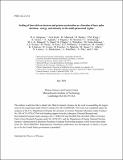| dc.contributor.author | Simpson, R.A. | en_US |
| dc.contributor.author | Scott, G.G. | en_US |
| dc.contributor.author | Mariscal, D. | en_US |
| dc.contributor.author | Rusby, D. | en_US |
| dc.contributor.author | King, P.M. | en_US |
| dc.contributor.author | Grace, E. | en_US |
| dc.contributor.author | Aghedo, A. | en_US |
| dc.contributor.author | Pagano, I. | en_US |
| dc.contributor.author | Sinclair, M. | en_US |
| dc.contributor.author | Armstrong, C. | en_US |
| dc.contributor.author | Manuel, M. J.-E. | en_US |
| dc.contributor.author | Haid, A. | en_US |
| dc.contributor.author | Flippo, K. | en_US |
| dc.contributor.author | Winslow, L. | en_US |
| dc.contributor.author | Gatu Johnson, Maria | en_US |
| dc.contributor.author | Frenje, Johan A. | en_US |
| dc.contributor.author | Neely, D. | en_US |
| dc.contributor.author | Kerr, S. | en_US |
| dc.contributor.author | Williams, G.J. | en_US |
| dc.contributor.author | Andrews, S. | en_US |
| dc.contributor.author | Cauble, R. | en_US |
| dc.contributor.author | Charron, K. | en_US |
| dc.contributor.author | Costa, R. | en_US |
| dc.contributor.author | Fischer, B. | en_US |
| dc.contributor.author | Maricle, S. | en_US |
| dc.contributor.author | Stuart, B. | en_US |
| dc.contributor.author | Albert, F. | en_US |
| dc.contributor.author | Lemos, N. | en_US |
| dc.contributor.author | Mackinnon, A. | en_US |
| dc.contributor.author | MacPhee, A. | en_US |
| dc.contributor.author | Pak, A. | en_US |
| dc.contributor.author | Ma, T. | en_US |
| dc.date.accessioned | 2025-03-21T20:22:53Z | |
| dc.date.available | 2025-03-21T20:22:53Z | |
| dc.date.issued | 2021-07 | |
| dc.identifier | 21ja052 | |
| dc.identifier.uri | https://hdl.handle.net/1721.1/158732 | |
| dc.description | Submitted for publication in Physics of Plasmas | |
| dc.description.abstract | A scaling study of short-pulse laser-driven proton and electron acceleration was conducted as a function of pulse duration, laser energy, and laser intensity in the multi-picosecond (ps) regime (∼0.8 ps–20 ps). Maximum proton energies significantly greater than established scaling laws were observed, consistent with observations at other multi-ps laser facilities. In addition, maximum proton energies and electron temperatures in this regime were found to be strongly dependent on the laser pulse duration and preplasma conditions. A modified proton scaling model is presented that is able to better represent the accelerated proton characteristics in this multi-ps regime. | |
| dc.publisher | AIP | en_US |
| dc.relation.isversionof | doi.org/10.1063/5.0023612 | |
| dc.source | Plasma Science and Fusion Center | en_US |
| dc.title | Scaling of laser-driven electron and proton acceleration as a function of laser pulse duration, energy, and intensity in the multi-picosecond regime | en_US |
| dc.type | Article | en_US |
| dc.contributor.department | Massachusetts Institute of Technology. Plasma Science and Fusion Center | |
| dc.relation.journal | Physics of Plasmas | |
